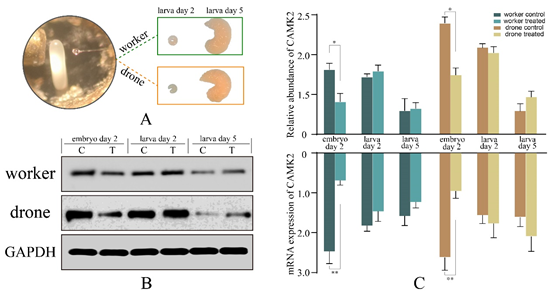A study revealing phosphoregulatory network during embryogenesis of honey bee workers and drones
Date:2022-10-27
The Institute of Apicultural Research of Chinese Academy of Agricultural Sciences (IARCAAS) recently analyzed the phosphoregulatory network during embryogenesis of honey bee workers and drones, providing a theoretical basis for the in-depth understanding of molecular mechanisms during embryogenesis of honey bees. Relevant findings were published in Frontiers in Cell and Developmental Biology.

Embryogenesis of honey bees is an important organogenetic period, with an important significance on the formation of biological properties of adult honey bees. Phosphorylation of proteins is a common way of regulation in living organisms and plays an important role in the process of cellular signaling transduction. However, we know little about the phosphoregulatory network during embryogenesis of honey bees. Therefore, our team made a systematic analysis on the phosphoregulatory network during embryogenesis and key kinases and regulatory proteins by interdisciplinary research means of proteomics, bioinformatics and genomics.
During embryonic development of honey bees, we identified a series of phosphorylated proteins and phosphorylated sites, and predicted relevant phosphokinases. According to the findings, honey bee worker bees and drones were similar in their overall strategies during embryonic development. In newborn embryos, protein kinase A played an important role in regulating cell proliferation and germ layer formation. During the middle embryogenesis, kinase subfamily dual-specificity tyrosine-regulated kinases, cyclin-dependent kinases (CDKs) and induced pathways relating to protein synthesis and morphogenesis enhanced germ layer development, organogenesis and dorsal closure. In comparison of embryogenesis of bee workers and drones, it was found that the two formulated distinct regulatory strategies, which were coincident with the trajectories of embryogenesis of bee workers and drones. Finally, key regulatory kinase CAMK2 was functionally validated by RNA interference. This is the most comprehensive and in-depth honey bee embryo phosphoproteome data so far, providing a theoretical basis for subsequent studies on honey bee embryonic stem cells and transgenosis.